Hokusai Beyond The Great Wave
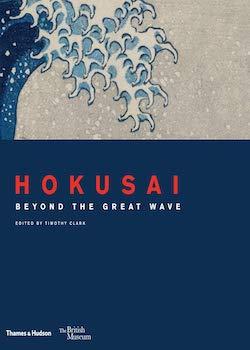
Edited by Timothy Clark
Thames and Hudson and The British Museum, 2017
ISBN-13: 978-0500094068
Review by Sir Hugh Cortazzi
It is very rare for a book on a single artist to make the bestseller list as this did. Indeed it was the top bestseller in one list that I saw and the book had to be reprinted.
Anyone who managed to visit the Hokusai exhibition at the British Museum this summer must have been impressed by Hokusai’s genius as a painter and print artist. They will find in this volume with its wealth of colour illustrations and the scholarly essays that accompany them a valuable reminder of what they saw as well as insights into Hokusai’s life and work. For those who failed to get tickets or missed the exhibition this volume, while no substitute for the exhibition itself, will give them a taste of what they missed. A copy should be in the library of anyone with an interest in Japanese art.
The volume does not pretend to be a catalogue of all Hokusai’s works. As he produced around 3000 colour prints, many hundreds of paintings, and numerous sketches in his long life, to list and reproduce them all would require many volumes, but the selection from his late career presented in this volume is an excellent introduction to Hokusai’s art and the bibliography points to other works on Hokusai that the student can consult.
Tim Clark, the editor and British Museum curator in his essay ‘Late Hokusai backwards’ begins: “Hokusai believed that the older he got the better his art became”. Thirty-two paintings produced when he was 88 have survived and twelve have been preserved from his ninetieth and final year. As the name which he adopted in later life Gakyō rōjin (‘picture-mad old man’ if literally translated) implies he could not stop drawing and painting. Sadly he did not manage to live to 100 when he hoped to have achieved ‘a divine state’ in his art.
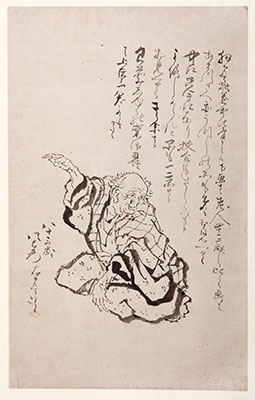
Drawing in a letter,
ink on paper
1842
National Museum of Ethnology,
Leiden, RMV3513-1496
Clark reminds us that Hokusai in middle age had performed several tremendous feats of outdoor performance art such as painting gigantic head-and-shoulder images of Daruma. Hokusai had a great sense of the ridiculous and his published collections of humorous sketches (Hokusai manga) are a high point in the long tradition of satirical drawing first manifest in the medieval Chōjū jinbutsu giga depiction of animals behaving like human beings.
Hokusai was extraordinarily productive during his long life. He wrote stories and poems and illustrated many books. While conscious of his own genius and worth (the famous novelist Kyokutei Bakin noted that Hokusai’s fees were ‘unusually high’) knew that in producing woodblock prints he had to work closely with the various craftsmen involved in the production process.
Hokusai was an innovator. From his early twenties he adopted elements of European perspective adding depth to his depictions of the sea and mountains. He had great imagination and an exceptional eye for the beauties of the natural world. Perhaps above all it was his instinct for colour and composition, which made him such an exceptionally great artist. He seemed to know instinctively how to compose a picture to make maximum impact on the viewer.
These were probably the principal reasons why once Japanese prints began to reach Europe Hokusai became the focus of interest of French painters and to have such an important influence on the French impressionists. Indeed Hokusai in the nineteenth century perhaps because woodblock prints were so easily transportable and plentiful came to be seen in the West as Japan’s greatest painter. In traditional Japanese art circles in the late nineteenth he was not accorded the same recognition although he did many hanging scroll paintings of landscapes and beauties in the Japanese classical tradition. His fame abroad was based on woodblock prints, which in snobbish Japanese eyes were seen as rather vulgar.
His genius and his fame as one of the greatest artists in the world are now duly recognized in Japan as in the rest of the world.
Here as an indication of the delights of this volume are four examples of the works that are illustrated.
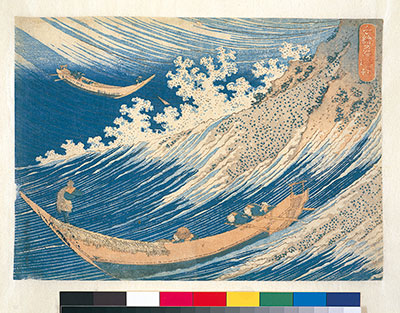
from the series A Thousand Pictures
of the Sea (Chie no umi)
Colour woodblock print
About 1833
Chiba City Museum of Art
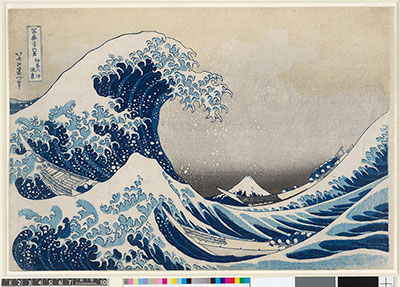
from the series Thirty-six Views of
Mt. Fuji (Fugaku hyakkei)
Colour woodblock print
About 1831
British Museum
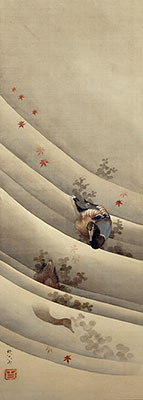
water
Hanging scroll,
ink and colour
on silk
1847
British Museum
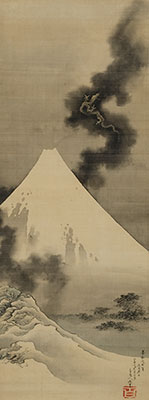
above Mt Fuji
Hanging scroll,
ink and slight
colour on silk
11th (or 23rd) day,
first month, 1849
Hokusaikan, Obuse

